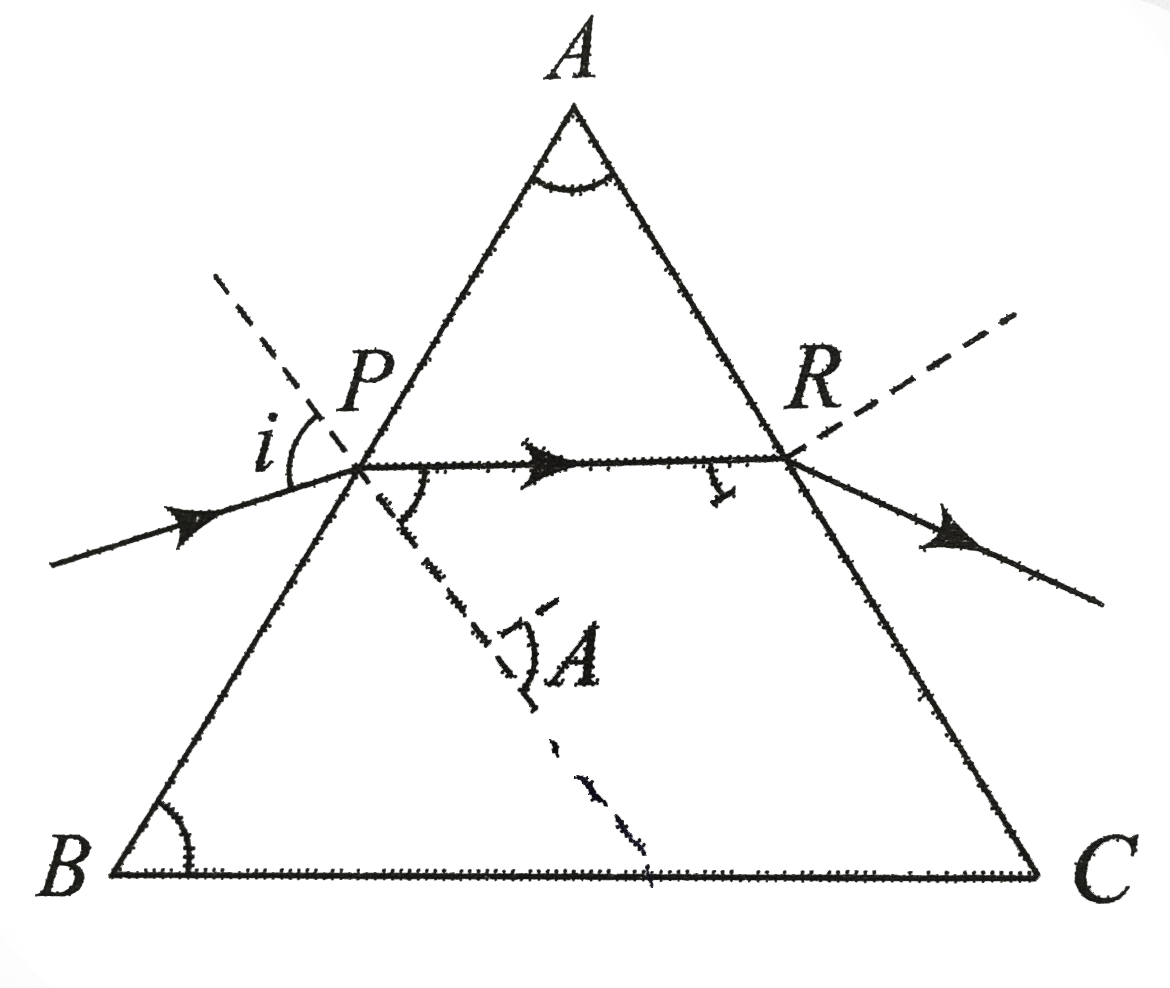A ray of light undergoes deviation of 30∘ when incident on an equilateral prism of refractive index √2. what is the angle subtended by the ray inside the prism with the base of the prism?
To solve the problem step by step, we will follow the logical deductions based on the properties of an equilateral prism and the concept of minimum deviation.
Step 1: Understand the Given Information
We have an equilateral prism with:
- Refractive index n=√2
- Angle of the prism A=60∘ (since it’s equilateral)
- Angle of deviation δ=30∘
Step 2: Check if the Situation is Minimum Deviation
To determine if the deviation is at its minimum, we can use the formula for minimum deviation:
n=sin(δ+A2)sin(A2)
Substituting the known values:
n=sin(30∘+60∘2)sin(60∘2)=sin(45∘)sin(30∘)
Using the known values of sine:
sin(45∘)=√22,sin(30∘)=12
Thus,
n=√2212=√2
Since this matches the given refractive index, we confirm that the situation is indeed one of minimum deviation.
Step 3: Determine the Angles of Refraction
In the case of minimum deviation, the angles of refraction at both faces of the prism are equal:
R1=R2=R
From the geometry of the prism, we know:
R=A2=60∘2=30∘
Step 4: Find the Angle Subtended by the Ray Inside the Prism
The angle subtended by the ray inside the prism with the base can be determined by considering the geometry:
- The angle of incidence at the first face is i=R+angle subtended
- Since the ray is refracted at an angle R=30∘ and the total angle at the base of the prism is 60∘, the angle subtended by the ray inside the prism with the base is:
Angle subtended=60∘−R=60∘−30∘=30∘
Final Answer
The angle subtended by the ray inside the prism with the base of the prism is 30∘.
---
We have an equilateral prism with:
- Refractive index n=√2
- Angle of the prism A=60∘ (since it’s equilateral)
- Angle of deviation δ=30∘
To determine if the deviation is at its minimum, we can use the formula for minimum deviation:
n=sin(δ+A2)sin(A2)
Substituting the known values:
n=sin(30∘+60∘2)sin(60∘2)=sin(45∘)sin(30∘)
Using the known values of sine:
sin(45∘)=√22,sin(30∘)=12
Thus,
n=√2212=√2
Since this matches the given refractive index, we confirm that the situation is indeed one of minimum deviation.
In the case of minimum deviation, the angles of refraction at both faces of the prism are equal:
R1=R2=R
From the geometry of the prism, we know:
R=A2=60∘2=30∘
The angle subtended by the ray inside the prism with the base can be determined by considering the geometry:
- The angle of incidence at the first face is i=R+angle subtended
- Since the ray is refracted at an angle R=30∘ and the total angle at the base of the prism is 60∘, the angle subtended by the ray inside the prism with the base is:
Angle subtended=60∘−R=60∘−30∘=30∘
The angle subtended by the ray inside the prism with the base of the prism is 30∘.
Topper's Solved these Questions
- REFRACTION OF LIGHTBOOK - DC PANDEY ENGLISHCHAPTER - REFRACTION OF LIGHTEXERCISE - Level 1 Assertion And Reason
13 Videos
- REFRACTION OF LIGHTBOOK - DC PANDEY ENGLISHCHAPTER - REFRACTION OF LIGHTEXERCISE - Level 1 Objective
38 Videos
- REFRACTION OF LIGHTBOOK - DC PANDEY ENGLISHCHAPTER - REFRACTION OF LIGHTEXERCISE - Exercise 31.7
2 Videos
- REFLECTION OF LIGHTBOOK - DC PANDEY ENGLISHCHAPTER - REFLECTION OF LIGHTEXERCISE - Subjective
9 Videos
- SEMICONDUCTORSBOOK - DC PANDEY ENGLISHCHAPTER - SEMICONDUCTORSEXERCISE - Subjective
12 Videos
Similar Questions
A ray of light undergoes a deviation of 30∘ when incident on an equilateral prism of refractive index √2.
What is the angle subtended by the ray inside the prism with the base of the prism?

View SolutionA ray of light undergoes deviation of 30∘ when incident on an equilateral prism of refractive index √2. The angle made by the ray inside the prism with the base of the prism is
View SolutionA ray of light suffers a minimum deviation when incident on equilateral prism of refractive index √2 The angle of deviation is
View SolutionWhat is the angle of incidence for an equilateral prism of refractive index √3 so that the ray si parallel to the base inside the prism?
View SolutionA light ray is normally incident onone face of equilateral glass prism of refractive index √2. The deviation of light ray is
View SolutionThe angle of incidance for an equilateral prism is 60∘. What should be the refractive index of prism so that the ray is parallel to the base inside the prism ?
View SolutionA ray of light is incident normally on one face of an equilateral prism of refractive index 1.5. The angle of deviation is: (Given sin−1.23=42∘)
View SolutionIf the angle of minimum deviation is of 60∘ for an equilateral prism , then the refractive index of the material of the prism is
View SolutionFind the angle of minimum deviation for an equilateral prism made of a material of refractive index 1.732. What is the angle of incidence for this deviation ?
View SolutionA ray of light is incident normally on one of the faces of a prism of apex angle 30 degree and refractive index √2. The angle of deviation of the ray in degrees is
View Solution